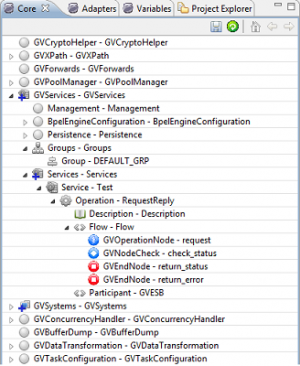Difference between revisions of "The views"
(Created page with "To the left of {{VULCON}} Prospective there are three views of {{VULCON}}: thumb|view {{VULCON}} *Core: Represents the core configuration file of {{GVESB}...") |
|||
| Line 3: | Line 3: | ||
*Core: Represents the core configuration file of {{GVESB}}. | *Core: Represents the core configuration file of {{GVESB}}. | ||
*Adapters: Represents the configuration file of the adapters of {{GVESB}}.The adapters view may change depending on the installation or the license of {{VULCON}} that you use. | *Adapters: Represents the configuration file of the adapters of {{GVESB}}.The adapters view may change depending on the installation or the license of {{VULCON}} that you use. | ||
| − | *Variables:Represents the file where you define the variables identified in previous views. | + | *Variables: Represents the file where you define the variables identified in previous views. |
| + | Sight Core expanding the voice GVServices - GVServices, you may notice that the configuration of services is divided into two major components: | ||
| + | *Groups: The element groups in turn contains n sub-elements of type group. Each group contains the configuration of the service group. A group of services allows you to manage the state of activation of multiple services simultaneously. | ||
| + | *Services: Contains the configuration of services. Are specified for each service enabled clients, server systems, operating procedures, notes and more. | ||
Revision as of 09:56, 24 January 2012
To the left of VulCon Prospective there are three views of VulCon:
- Core: Represents the core configuration file of GreenVulcano® ESB.
- Adapters: Represents the configuration file of the adapters of GreenVulcano® ESB.The adapters view may change depending on the installation or the license of VulCon that you use.
- Variables: Represents the file where you define the variables identified in previous views.
Sight Core expanding the voice GVServices - GVServices, you may notice that the configuration of services is divided into two major components:
- Groups: The element groups in turn contains n sub-elements of type group. Each group contains the configuration of the service group. A group of services allows you to manage the state of activation of multiple services simultaneously.
- Services: Contains the configuration of services. Are specified for each service enabled clients, server systems, operating procedures, notes and more.
